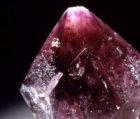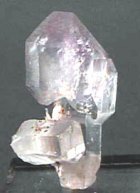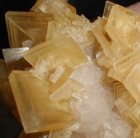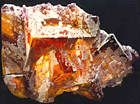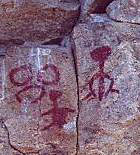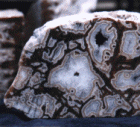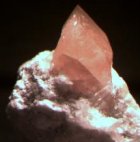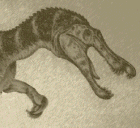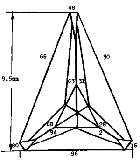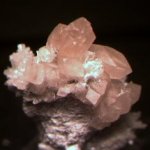 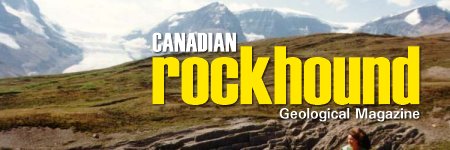 | |||||||||
| Back Issues | News & Events | Dealers | Classifieds | Web Links | Home | ||||||||
| |
Winter / Spring 2000 Volume 4, Number 1
Amethyst: Ontario's Mineral Emblem Amethyst is a purple colored variety of the common mineral quartz. Its crystalline form, scarcity, color, and its occurrence in northwestern Ontario qualified it as the Provincial government's choice as a Mineral Emblem for Ontario in 1975.
Spruce Claim, located east of North Bend, Washington, is well known for spectacular quartz and pyrite combination plates. Specimens from this deposit are found in private and museum collections world-wide. This article reports on a special trip to a new amethyst sceptre zone discovered recently.
The Rock Candy Mine is a world-class mineral locality. Situated near Grand Forks, British Columbia, this mine is known for the beautiful and unique plates of fluorite and barite crystals it has produced. Some plates of these crystals have weighed up to one hundred fifty pounds.
The list of visitors from around the world who have made their way to the Ben E. Clement Mineral Museum and signed the guest book provides a testament to the significance of the Ben E. Clement collection. This museum houses the largest fluorite mineral collection in the world.
They are referred to as Indian writing or Indian drawings. Who created this early rock art? How did they make the paint? What do the drawings mean? Such questions are asked today as they were over one hundred years ago. This article looks at the rock art paintings found in southern British Columbia.
About 12 years ago, a remarkable discovery occurred near Thunder Bay, Ontario. While an area was being re-logged, a bulldozer struck the corner of a shallow outcrop. As it turned out, the exposed rock was found to contain the world's largest known agate vein.
Collecting at the Black Lake This past year I visited the Black Lake Mine near Asbestos, Québec, to collect minerals. Find out how an ordinary trip lead me to an exciting find of fine andradite and demantoid garnets.
Genuine rockhounders are few and far between in the gold mining town of Yellowknife, Northwest Territories. While most Northerners pursue a myriad of outdoor recreational activities, Robert Carr has quietly gone about his hobby of rockhounding. Twenty-five years later, he has the quintessential collection of mineral specimens from this part of the world.
Dorfmanite is a very rare mineral, first described in 1981 from the Kola Penninsula, Russia. There is an interesting occurrance of Dorfmanite at the Tanco Mine, where it is found in the Lithiophosphate-Tancoite-radial pink Apatite-Cesium Analcime assemblage.
By Steve Brusatte In 1997 fossil hunter David Varrichio discovered Suchomimus, a new species of fish-eating dinosaur that may hold the key to understanding dinosaur diversity. Steve Brusatte reports on the exciting new Suchomimus dinosaur exhibit at the Chicago Children's Museum.
Geology of the Fraser Valley During the late Cretaceous and early Tertiary period, the area encompassed by the Lower Fraser Valley was a low lying coastal-plain surrounded by low hills, enjoying a sub-tropical climate. Over millions of years, various geological processes resulted in the landscape and geology we see today in this region of British Columbia.
Virtually all earthquakes are caused by the slippage of masses of rock along fractures called faults. A fault zone is where the edges of two plates meet. The movement of tectonic plates slowly creeping builds up so much strain energy at the fault zones that they must slip. The result is an earthquake.
By Phyllis Richardson Early in 1967, suggestions were put forth by the B.C. Faceters' Guild for a worthy Canadian Centennial Project. The result was the construction of a Centennial Tiara for the Pacific National Exhibition's "Miss P.N.E." Here's a historical look back at this interesting project.
One of the projects of the B.C. Faceters' Guild was for its members to facet a famous diamond replica. One project, the "Centennial Cut", was used for the large oval citrine on the Pacific National Exhibition's Centennial Tiara. Here are the faceting designs and steps we used to produce this unique cut.
The Dogwood motif was chosen for the Pacific National Exhibition's Centennial Tiara. The shape I chose was triangular, which was to be the Dogwood bud. Here are the faceting designs and steps used to produce this interesting cut.
Roadside Geology of Ontario: North Shore of If you've ever wondered about the interesting and unique geology and scenery of northwestern Ontario, you will be pleased to learn about a new guidebook by Edgar G. Pye. This book will be appreciated by rockhounds who intend to explore the region along Lake Superior's northern shore between Thunder Bay and Sault Ste. Marie, Ontario.
|
||||||||

Copyright © 2000 Canadian Rockhound
Magazine Issues |
News & Events |
Junior Rockhound |
Resources
|
|||||||||
